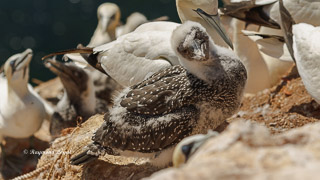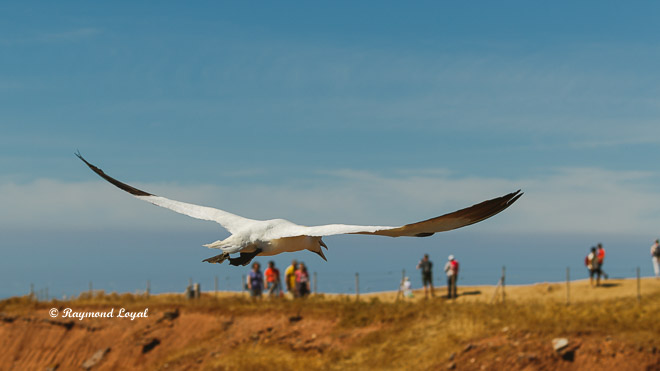The Northern Gannet (Morus bassanus)
The Northern Gannet is a large seabird, larger than gulls, with a longish body, long and narrow wings, long neck and a pointed bill. They are very social birds when they are at shore for breeding. Outside the breeding season they are more solitary.
The Gannet is at home in the northern Atlantic where it takes the place of the the Albatross which lives in the southern hemisphere.
Their southernmost breeding colony is on the German island Heligoland where at least 2,000 breeding pairs stay at the island every year since 1991. It is quite a site to stand on top of the cliffs and watch these lovely birds.

Description - Characteristics: Northern Gannet
Breeding – Clutch – Measurements – Habitat – Diet - Threats
Taxonomy:
Order: Procellariiformes
Family: Sulidae
Genus: Morus
Species: Northern Gannet
Scientific Name: Morus bassanus
Names and Synonyms of the Northern Gannet
Name in German: Basstölpel
Name in Czech: Terej bílý
Name in Slovak: Sula biela
Name in Hungarian: Szula
Name in Croat: Bluna
Name in French: Fou de Bassan
Name in Spanish: Alcatraz Atlántico
Name in Portuguese: Ganso-patola
Name in Dutch: Jan-van-gent
Name in Italian: Sula
Name in Iceland: Súla
Name in North Sami: Suvla
Name in Faroer: Grásúla, Hvítsúla, Oyðisúla, Súla
Name in Finnish: Suula
Name in Danish: Sule
Name in Swedish: Havssula
Name in Polish: Głuptak
Name in Russian: Северная олуша
Characteristics of the Northern Gannet
Distribution: Distributed at the shorelines and islands of the North Atlantic. Seems to extend its area. Colonies in Norway, Iceland, Faroe, Shetlands, Orkneys, British Isles, French North Sea coast, German Island of Heligoland in the southern North Sea..
Movements: Adults are sedentary. Juveniles migrate to the East Atlantic and southwards to tropical West Africa before they return to their breeding colonies.
Habitat: Breeders on rocky islands close to the coast, cliffs. Nesting sites must be exposed to wind and close to feeding grounds.
Behaviour: solitary and often in pairs.
Field Characteristics: Size similar to goose, long stretched body, long pointed wings; large, straight and pointed bill; long pointed tail. Adult birds are white with black primaries. Head and neck yellowish. Lore and chin black
Bill: bluish white.
Eye-ring: blue
Tarsus and feet: black-brown with greenish lines on tarsus and back of toes.
Iris: adult light grey with thin black edge.
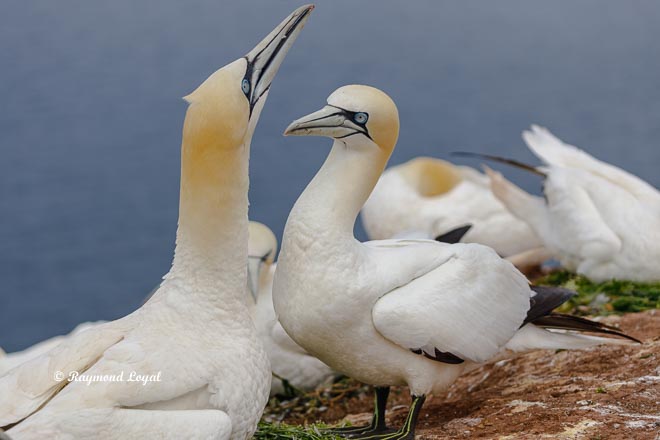
Measurements
Size: 87-100 cm
Weight: c. 2300-3600 g
Wingspan: 165-180 cm
Wing: 460-520 mm
Voice: Very noisy, can be heard over large distances, especially in colony. Mainly utters sounds like arrh-arrh-arrh; also when taking off they utter a sound like oo-ah.
Breeding
Maturity: Usually in the 4th year, mainly between 5-6 year. Three-year-old can already appear on the fringes of the colony. Nest sites are chosen by ♂ in 5-6 year.
Mating Season: Monogamous breeding pair, re-mating is mainly the case.
Clutches per breeding season1 clutch, only rarely 2
Breeding: Earliest begin end of March / early April, mainly mid-April/May to June (July latest), .
Nest: Scratched mould on foundation of earth and mud, lined with green plants, seaweeds, and nearly everything found on the ocean, or nearby the nest. Nest building continues during the entire breeding period until the parents leave nest and nestling. Nowadays, even parts of fishing nets, plastic straps are brought to the nest as building material. While sitting on the nest, birds do steal building material from neighbouring nests. Than can lead to massive conflicts between neighbours. Nest site on cliff ledges, on top of cliffs and outcrops.

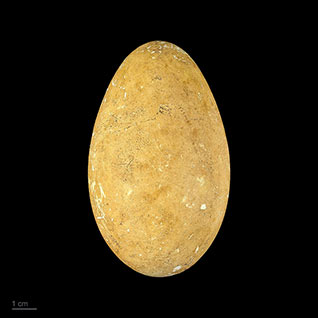
Clutch: 1 egg, rarely 2
Eggs: creme-coloured long oval egg.
Egg Measurements:
Length: 62.5-87.5 mm
Width: 43.1-53.7 mm
Ø: 78.1x49.1 mm (n=44)
Egg weight: 70.0-118.0 g
shell weight: 8.0-13.3 g; Ø 11.6 g
Recurrent Clutch: possibly when clutch is lost in the early days, two additional clutches possible.
Incubation: 44 (42-45) days, both parents share the task of incubating. After 24 hours at the latest, the breeding parent is relieved from its duties on the nest.
Fledging: Chicken stay at the nest and do not wander around. Juveniles are fed by parents until a few days before leaving the nest. Parents leave the nestling several days before the juvenile. Nestlings leave nest and cliff ledge after 84-97 (90) days. The juveniles are still unable to fly when leaving the nest. They glide with open wings down to the water surface. In case, they survive this jump down the cliff, they continue swimming on the ocean for the next days. It appears that at this point juveniles are fully independent.
Dependency: Before and even after fledging, juveniles have been observed in the company of adult birds, feeding them.
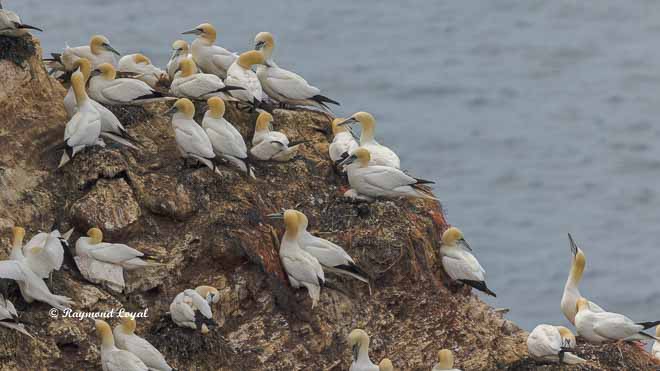
Miscellaneous
Food: Mainly fish, sized between 2.5 to 45 cm, mostly haddock, herring, mackerel, sandeels, sprats, any sort of cod fish.
Longevity: The oldest known ringed bird of a Northern Gannet reached an age of 32 years and 4 months.
Mortality: In their first year juveniles are subject to a mortality rate of c. 60%. Only 25% of all hatched juveniles only ever reach maturity in their 5th year. With adults, mortality stands at c. 6-9%.
Threats: Avian flu, parasites, sea eagles and other large birds of prey, skuas, scavengers, dogs and foxes.
References
Bauer, Hans-Günther, Bezzel, Einhard et. al. (HG), Kompendium der Vögel Mitteleuropas, Volume 1+2, Sonderausgabe 2012, Aula Verlag, Wiebelsheim
Bauer, Hans-Günther, Bezzel, Einhard et. al. (HG), Kompendium der Vögel Mitteleuropas, Volume 3, Literatur und Anhang, Aula Verlag Wiebelsheim, 2. vollständig überarbeitete Auflage 1993
Bezzel, Einhard, Kompendium der Vögel Mitteleuropas, Non-Passeriformes, Volume 1, AULA-Verlag Wiesbaden, 1985
Bruun/Singer/König/Der Kosmos Vogelführer, Franck'sche Verlagshandlung Stuttgart, 5. Auflage 1982
Glutz von Blotzheim, Urs et. al (HG), Handbuch der Vögel Mitteleuropas, Vol 1, Gaviiformes - Phoenicopteriformes, Akademische Verlagsgesellschaft Wiesbaden, 1966
Svenson, Lars et. al, Collins Bird Guide, Harper Collins London, 2009, revised and reprinded 2021
Image Credits
Egg of Herring Gull - Source: by Roger Culos - Own works, CC BY-SA 4.0, https://commons.wikimedia.org/w/index.php?curid=75547468







